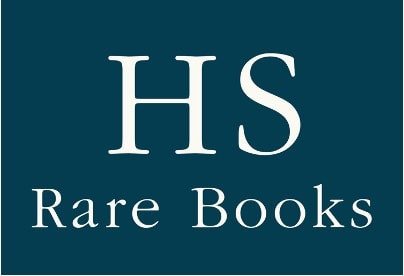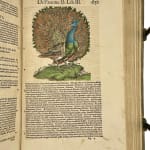





Gessner, Conrad
Historiae animalium Liber I (-IV), 1551-1558. Zürich. Christoph Froschauer.
Extraordinary copy of the first edition of this “encyclopaedia of contemporary knowledge” (PMM), here with the woodcuts in contemporary color and in uniform contemporary bindings
First edition, a spectacular set with the woodcut in fine contemporary color and housed in uniform contemporary bindings. Conrad Gesner (1516-1565) was one of the great polymaths of the Renaissance and one of the founders of modern zoology. “His History of Animals is an encyclopaedia of contemporary knowledge, intended to replace not only medieval compilations but even Aristotle's work of the same title... Although the Historia Animalium does not yet show any recognition of a connexion between different forms of living nature and fails to conform to our modern ideas of biological research, it was a great step forward and remained the most authoritative zoological book between Aristotle and the publication of Ray's classification of fauna in 1693” (PMM).
First edition, a spectacular set with the woodcut in fine contemporary color and housed in uniform contemporary bindings. Conrad Gesner (1516-1565) was one of the great polymaths of the Renaissance and one of the founders of modern zoology. “His History of Animals is an encyclopaedia of contemporary knowledge, intended to replace not only medieval compilations but even Aristotle's work of the same title... Although the Historia Animalium does not yet show any recognition of a connexion between different forms of living nature and fails to conform to our modern ideas of biological research, it was a great step forward and remained the most authoritative zoological book between Aristotle and the publication of Ray's classification of fauna in 1693” (PMM).
P.O.R.
Further images
Four books in 3 volumes Folio (400x 250 mm). Liber primus de quadrupedibus viviparis. [20] ff, 1104 pp., [6] ff. - Liber III. De Avium natura. [18] ff. of which 1 blank, 779 pp. - Lib. II de quadrupedibus oviparis. [4] ff. of which 1 blank110 pp., [1] blank leaf, 27 pp. - Liber IIII. de Piscium & Aquatilium animatium natura . [20] ff, 1297 pp., [1] blank leaf. Devices on titles, author's portrait, initials at the beginnings and 1079 depictions of animals, all in woodcut and coloured by a contemporary hand. Uniformly bound in contemporary blindstamped pigskin over wooden boards, each volume with two clasps, one volume with leaf markers on foredge. Corners and edges minimally worn and scuffed, small flaw to rear cover of volume I. Some foxing, staining and browning in places.
The first four volumes deal with quadrupeds, birds and fishes. A fifth volume with snakes and scorpions was published posthumously in 1587 by Gessner's friends Carron and Wolf and, as is often the case, is not included in the present set. Gessner drew on many sources to create his Historia Animalium, including accounts from classical authors, correspondences from other natural historians, and his own personal observations. The sources are listed in an introductory section Catalogi authorum with the mention of 321 names, 52 of which he refers to as 'learned men'.
The work includes extensive information on mammals, birds, fish, and reptiles. It describes in detail their daily habits and movements. It also includes their uses in medicine and nutrition. Historia animalium shows the animals' places in history,literature and art.
But the more visible novelty lies in the illustrations. Gessner had a wide network of contacts, and he unearthed or solicited the best images he could find for his text. Some are better than others, but all are a great improvement on the illustrations in earlier naturalistic works.
“A number of copies was published with hand-coloured illustrations 'for customers who are not deterred by the higher price” as Gessner explains in his preface De picturis animalium in hoc opera" (Wellisch).
The Historia animalium is the first modern zoological work that attempts to describe all the animals known, and the first bibliography of natural history writings.
PMM 77; VD16 G 1723, G 1724, G 1730, G 1738; Adams G 532, 534-535; BM STC German 358; Rudolphi 384, 438, 454, 487; Nissen ZBI 1549, 1550, 1553, 1556; Nissen IVB 349 (III.); Brunet II, 156; Wellisch A 23.1-A 26.1.
The first four volumes deal with quadrupeds, birds and fishes. A fifth volume with snakes and scorpions was published posthumously in 1587 by Gessner's friends Carron and Wolf and, as is often the case, is not included in the present set. Gessner drew on many sources to create his Historia Animalium, including accounts from classical authors, correspondences from other natural historians, and his own personal observations. The sources are listed in an introductory section Catalogi authorum with the mention of 321 names, 52 of which he refers to as 'learned men'.
The work includes extensive information on mammals, birds, fish, and reptiles. It describes in detail their daily habits and movements. It also includes their uses in medicine and nutrition. Historia animalium shows the animals' places in history,literature and art.
But the more visible novelty lies in the illustrations. Gessner had a wide network of contacts, and he unearthed or solicited the best images he could find for his text. Some are better than others, but all are a great improvement on the illustrations in earlier naturalistic works.
“A number of copies was published with hand-coloured illustrations 'for customers who are not deterred by the higher price” as Gessner explains in his preface De picturis animalium in hoc opera" (Wellisch).
The Historia animalium is the first modern zoological work that attempts to describe all the animals known, and the first bibliography of natural history writings.
PMM 77; VD16 G 1723, G 1724, G 1730, G 1738; Adams G 532, 534-535; BM STC German 358; Rudolphi 384, 438, 454, 487; Nissen ZBI 1549, 1550, 1553, 1556; Nissen IVB 349 (III.); Brunet II, 156; Wellisch A 23.1-A 26.1.
Provenance: Johann Heinrich Lavater, Johann Rudolf Lavater; manuscript inscription on titles “D'Apples 1701”, probably Jean Pierre d'apples (1656-1733), physician and rector of the university of Lausanne; C. Charbonniere; Antiquariat August Laube; Swiss private collection.
Join our mailing list
* denotes required fields
We will process the personal data you have supplied in accordance with our privacy policy (available on request). You can unsubscribe or change your preferences at any time by clicking the link in our emails.






